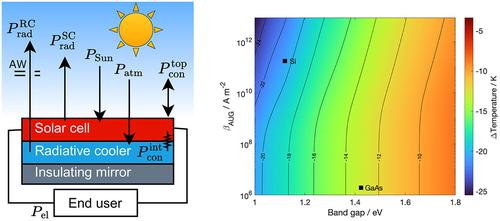当前位置:
X-MOL 学术
›
Prog. Photovoltaics
›
论文详情
Our official English website, www.x-mol.net, welcomes your feedback! (Note: you will need to create a separate account there.)
Extended detailed balance modeling toward solar cells with cement-based radiative coolers
Progress in Photovoltaics ( IF 6.7 ) Pub Date : 2023-12-13 , DOI: 10.1002/pip.3758 Matteo Cagnoni 1 , Pietro Testa 1 , Jorge S. Dolado 2, 3 , Federica Cappelluti 1
Progress in Photovoltaics ( IF 6.7 ) Pub Date : 2023-12-13 , DOI: 10.1002/pip.3758 Matteo Cagnoni 1 , Pietro Testa 1 , Jorge S. Dolado 2, 3 , Federica Cappelluti 1
Affiliation

|
Reducing the temperature of a solar cell increases its efficiency and lifetime. This can be achieved by radiative cooling, a passive and simple method relying on materials that dump heat into outer space by thermal emission within the atmosphere transparency window between 8 and . As most radiative coolers are expensive or possibly UV unstable, we have recently proposed cement-based solutions as a robust and cost-effective alternative. However, the assessment model used describes the cell in the radiative limit and with perfect thermal coupling to the cooler, in line with the literature. In this work, we lift these two approximations, by incorporating Auger and Shockley–Read–Hall nonradiative recombination and a finite heat transfer coefficient at the cell/cooler interface, to obtain a thermal description of the cell/cooler stack closer to reality, while preserving the universality and transparency of the detailed-balance approach. We use this model to demonstrate that the cell performance gains provided by a radiative cooler are underestimated in the radiative limit and are hence more prominent in devices with stronger nonradiative recombination. Furthermore, we quantify the relation between cell temperature and heat transfer coefficient at the cell/cooler interface and show how this can be used to define design requirements. The extended model developed, and the resulting observations provide important guidelines toward the practical realization of novel radiative coolers for solar cells, including cement-based ones.
中文翻译:

具有水泥基辐射冷却器的太阳能电池的扩展详细平衡模型
降低太阳能电池的温度可以提高其效率和寿命。这可以通过辐射冷却来实现,这是一种被动且简单的方法,依赖于通过在 8 到 8 之间的大气透明度窗口内的热发射将热量释放到外太空的材料。。由于大多数辐射冷却器价格昂贵或可能对紫外线不稳定,因此我们最近提出了基于水泥的解决方案作为稳健且经济高效的替代方案。然而,所使用的评估模型描述了处于辐射极限的电池,并且与冷却器具有完美的热耦合,与文献一致。在这项工作中,我们通过结合俄歇和肖克利-雷德-霍尔非辐射复合以及电池/冷却器界面处的有限传热系数,提升了这两个近似值,以获得更接近现实的电池/冷却器堆的热描述,同时保持详细平衡方法的普遍性和透明度。我们使用该模型来证明辐射冷却器提供的电池性能增益在辐射极限下被低估,因此在具有更强非辐射复合的设备中更为突出。此外,我们量化了电池温度和电池/冷却器界面处的传热系数之间的关系,并展示了如何使用它来定义设计要求。扩展模型的开发以及由此产生的观察结果为太阳能电池新型辐射冷却器(包括水泥基辐射冷却器)的实际实现提供了重要指导。
更新日期:2023-12-13
中文翻译:

具有水泥基辐射冷却器的太阳能电池的扩展详细平衡模型
降低太阳能电池的温度可以提高其效率和寿命。这可以通过辐射冷却来实现,这是一种被动且简单的方法,依赖于通过在 8 到 8 之间的大气透明度窗口内的热发射将热量释放到外太空的材料。。由于大多数辐射冷却器价格昂贵或可能对紫外线不稳定,因此我们最近提出了基于水泥的解决方案作为稳健且经济高效的替代方案。然而,所使用的评估模型描述了处于辐射极限的电池,并且与冷却器具有完美的热耦合,与文献一致。在这项工作中,我们通过结合俄歇和肖克利-雷德-霍尔非辐射复合以及电池/冷却器界面处的有限传热系数,提升了这两个近似值,以获得更接近现实的电池/冷却器堆的热描述,同时保持详细平衡方法的普遍性和透明度。我们使用该模型来证明辐射冷却器提供的电池性能增益在辐射极限下被低估,因此在具有更强非辐射复合的设备中更为突出。此外,我们量化了电池温度和电池/冷却器界面处的传热系数之间的关系,并展示了如何使用它来定义设计要求。扩展模型的开发以及由此产生的观察结果为太阳能电池新型辐射冷却器(包括水泥基辐射冷却器)的实际实现提供了重要指导。



























 京公网安备 11010802027423号
京公网安备 11010802027423号